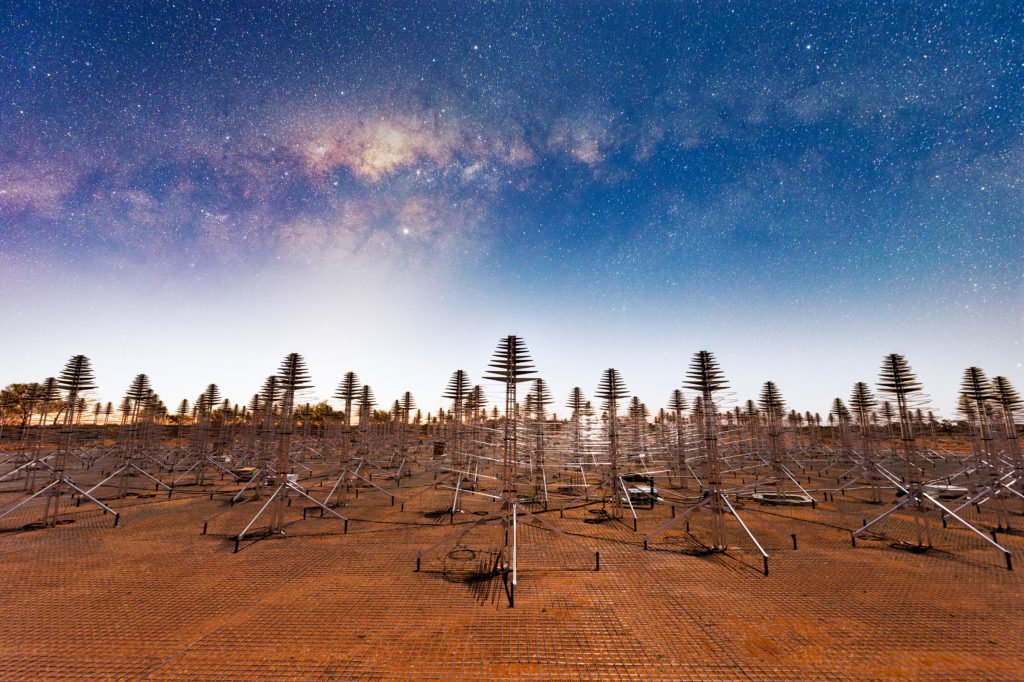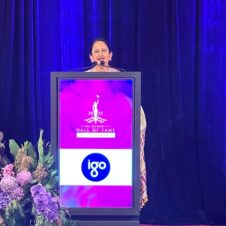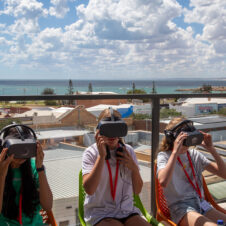Award-winning West Australian production company White Spark Pictures has received funding from Screen Australia, Screenwest and Lotterywest to produce Beyond the Stars, a virtual reality documentary about the world’s largest radio telescope—the Square Kilometre Array (SKA).

A 20-second exposure showing the Milky Way overhead the type of antennas to be used for the Square Kilometre Array in Australia. Credit: Michael Goh and ICRAR/Curtin.
The funding follows White Spark’s first virtual reality production, The Antarctica Experience, which is one of the most successful VR documentary experiences of all time.
White Spark creative director Briege Whitehead said it was great to have an opportunity to promote cutting-edge science happening in her home state.
“This production will allow people of all ages and cultural backgrounds to virtually experience the Australian site for the Square Kilometre Array—a part of the world that few will ever visit in person,” she said.
“It will be shot using specialised 360-degree cameras capable of extreme resolution.
“We’ll take audiences on a VR tour of CSIRO’s Murchison Radio Astronomy-Observatory through the eyes of the people working on the site, the astronomers who will eventually use the SKA, and the Wajarri Yamaji traditional land owners.”

White Spark Pictures Producer Jess Black preparing to film ICRAR/Curtin PhD candidate Kat Ross about the Murchison Widefield Array—a precursor to the Square Kilometre Array located at CSIRO’s Murchison Radio-astronomy Observatory in WA’s Mid West. Credit: ICRAR.

The White Spark Pictures crew (Briege Whitehead, Jess Black and Ben Ellard) filming amongst several of the 36 dish antennas that belong to CSIRO’s Australian SKA Pathfinder. Credit: ICRAR.
Beyond the Stars is also supported by the Department of Industry, Science, Energy and Resources, the International Centre for Radio Astronomy Research (ICRAR) and CSIRO, Australia’s national science agency.
ICRAR executive director Professor Peter Quinn, who is based at The University of Western Australia, said it’s an exciting time for the SKA.
“The world is coming together to build a telescope capable of observing the first stars and galaxies to appear in the Universe 13 billion years ago,” he said.
“After nearly two decades of designing and decision-making, construction of the telescope is set to start in Australia and South Africa in the course of next year.
“It’s an enormous international effort, and we’re keen to bring as many people as possible along for the ride through virtual reality.”

Composite image of the SKA-Low telescope in Western Australia. The image blends a real photo (on the left) of the SKA-Low prototype station AAVS2.0 which is already on-site, with an artists impression of the future SKA-Low stations as they will look when constructed. These dipole antennas, which will number in their hundreds of thousands, will survey the radio sky in frequencies as low at 50Mhz. Credit ICRAR and SKAO.
“Western Australia’s remote Murchison region is a truly special place,” said Rebecca Wheadon, CSIRO’s site entity leader for Australia’s SKA site.
“We have a profound duty to share this landscape, its cultural history and our role in building the world’s biggest radio telescope,” she said.
Beyond the Stars will feature at the new WA Museum Boola Bardip in late 2021, before touring to other Western Australian Museum venues in 2022.
White Spark Pictures specialises in international factual series and interactive productions. Previous productions from Ms Whitehead and White Spark have appeared on leading broadcast platforms including National Geographic, the History Channel, Discovery and Netflix.
The Antarctica Experience is among the top ten highest-grossing Australian theatrically-released documentaries, playing to sell-out audiences in major venues including Canberra’s National Museum of Australia and Sydney’s Australian Maritime Museum.
Production credit: Beyond the Stars is a White Sparks Pictures production. Principal production investment from Screen Australia in association with Screenwest & Lotterywest. Financed with support from the Department of Industry, Science, Energy and Resources, the International Centre for Radio Astronomy Research (ICRAR) and CSIRO.
ICRAR is a joint venture between Curtin University and The University of Western Australia with support and funding from the State Government of Western Australia.
Contacts:
Pete Wheeler — Media Contact, ICRAR
Ph: +61 423 982 018 E: Pete.Wheeler@icrar.org
Briege Whitehead — Creative Director, White Spark Pictures
Ph: +61 431 603 366 E: briege@whitesparkpics.com.au
Jess Reid — Media Contact, UWA
Ph: +61 8 6488 6876 E: Jess.Reid@uwa.edu.au

